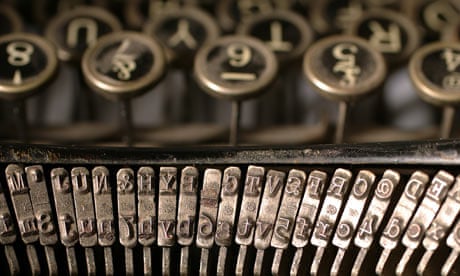"It was a dark and stormy night." The image of Snoopy sitting on top of his kennel rattling out the opening of his latest bestseller on a typewriter is as familiar as it is cherished. It is also a delightful send-up of the archetypal would-be author at work.
Endearing, yes, but dated. Today, we learn that possibly the world's very last typewriter factory – in Mumbai – has closed. Although its typewriting business has been just one small portion of the Godrej & Boyce manufacturing empire, founded in 1897 by the lawyer and inventor Ardeshir Godrej, a spokesman has told the global media that "currently the company has just 500 machines left". Hurry while stocks last, as the imposing Prima model dating from the 1950s, now selling for about £160, is sure to become a sought-after classic of pre-digital design.
Or is it? There are now millions of people worldwide tapping away on keyboards who have never sat in front of a typewriter, much less written with one. The machine that gave us the modern open-plan office, with its rows of clerks and typists, can seem as outmoded as Polaroid and Instamatic cameras, Super 8 film, Kodachrome, hand looms and horse-drawn ploughs. And yet, although it is true that desktop and laptop computers and any number of handheld devices have effectively replaced the typewriter in everyday use, there are many people who prefer these miniature desktop printing presses.
Typewriters still hold a certain romance: something to do with the Mad Men charm of whisky bottles, green eyeshades, low office lighting, the mechanical chatter of keyboards, the ting of bells and the saw-like rasp and slap of carriages as they are whipped back hastily for the next line of copy to be churned out. And, alongside the image of Charles Schulz's Snoopy, there are haunting scenes from so many films in which the typewriter has played a powerful role. Think of Schindler's List, the list itself being typed up. Or Jack Nicholson sitting alone in an out-of-season mountain resort hotel typing that one line over and over – "All work and no play makes Jack a dull boy" – before he goes stark staring mad and takes an axe to his family in Stanley Kubrick's The Shining.
Such connotations aside, the typewriter – refined over more than a century – remains a satisfying machine to anyone who likes to watch precision components at work. I still use my Olivetti Lettera 22 – an elegantly sculpted design by Marcello Nizzoli, dating from 1950 – for personal letters rather than for journalism and books. Cormac McCarthy has written all of his novels to date on this trusty companion. It is small, more tactile and a lot more fun to operate than the wireless iPad, although of course the latter can do so much more than type. It's a bit like comparing the cockpit of a Tiger Moth biplane to that of the latest Airbus.
A physicist friend of mine is currently wiring up another Lettera 22 so that I can plug it into a desktop and enjoy the benefits of both typing the old way and doing at least some of the things a modern computer can. This kind of steampunk word processor has become a popular contraption the world over. And why not?
Typewriter design never did stand still. Those who say that typewriters were too much bother, with all those inky ribbons, jammed keys and hours spent sploshing with correcting fluid, have been strangers to advanced machines such as the IBM Selectric, which first appeared in 1961. With its rapid-fire golf ball typing head and invaluable backspace correcting key, here was a marvel of modern office design, however cumbersome. Even my slimline Olivetti Lettera 22 (weighing in at 4kg) feels very heavy indeed compared to an Apple MacBook Air (335g).
New technologies naturally push old ones aside for any number of reasons – from practicality to the promise of new functions and efficiencies. And yet, just as photographers still find uses for Polaroid cameras, musicians retain a fondness for vinyl, and steam locomotives attract crowds of fans when they appear on main lines billowing between the latest electric trains, the typewriter will rattle through many a dark and stormy night yet.

Comments (…)
Sign in or create your Guardian account to join the discussion